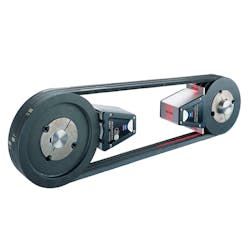A typical, large-sized airport operates about 2,000 fans and 2,000 pumps, driven by around 25 compressors. Add in 5,000 or so ball bearings for every conveyor belt, and there are millions of moving parts to maintain for an airport’s HVAC and conveyor systems alone.
With vigilant monitoring and use of the latest tools and technologies, airport maintenance professionals can drive savings through energy conservation and reduced downtime. Just as there are key indicators evaluated during a doctor’s office visit, there are vital signs every airport maintenance team can monitor to ensure an efficient-running and trouble-free operation.
HVAC System Shaft and Belt Alignment
Within each HVAC fan in an airport, there is a risk for improper shaft alignment between the fan’s electric motor and pump. This misalignment can increase moving-parts friction, which drives up energy consumption.
Reducing the friction enables equipment to work without consuming as much power, which can help an airport reduce the 150 giga-watt hours of electricity it uses on average. Also, 50 percent of costs related to rotating machinery breakdowns are caused by shaft misalignment.
Laser shaft alignment tools measure alignment without manual calculations associated with dial indicators. Laser alignment technology has evolved so that it can ensure machinery is standing evenly on the floor and that coupled machines are aligned on both the horizontal and vertical planes.
Laser alignment is a best maintenance practice for belt-driven equipment, which includes 70 percent of HVAC machinery. Traditional alignment methods using a straight edge or string to identify pulley misalignment do not reliably recognize problems that are too small to be visible to the naked eye, but are large enough to cause increased wear and unplanned downtime.
Diagnostic tools such as belt alignment tools can be fitted into the grooves of the pulley system of belt-driven equipment. Its receiver scans a 3-D target area to identify misalignment that is horizontal, vertical, or parallel (or all three) so that maintenance personnel can make needed adjustments.
Lubrication, Hot/Cold Spots, and Leak Detection
Too much or too little lubrication is another cause of increased energy usage in airports because it makes equipment such as luggage conveyor belts work harder to do the job. Automated lubrication systems ensure that the right amount of lubricant is applied to bearing housings over time.
In addition to enabling conveyors and other moving equipment to work with maximum energy efficiency, these lubrication systems also help airports conserve lubricant purchasing and disposal costs because they use only the necessary amount. On average, airports spend some $3 to dispose of every $1 of lubricant.
Checking for hot spots in moving equipment such as conveyors also conserves energy. These higher-than-normal temperature areas often indicate above-average friction, which increases energy consumption. Hand-held thermal cameras can give maintenance professionals a quick way to display thermal and visual pictures of equipment to identify problems such as overheating conveyor bearings or motors. This technology also can be used to monitor equipment to help ensure that it is not running at a temperature that may be too cool for optimal efficiency.
Air leaks and blockages are other sources of energy waste in airports. Thermal cameras can identify cold air leaks in buildings. Ultrasonic leak detectors can search for energy-wasting air leaks in HVAC system piping that runs throughout airport facilities.
Vibration and Speed
Vibration and speed round out the remaining 'vital signs' airport maintenance teams can monitor to ensure moving equipment isn’t consuming too much energy by working too hard or running too quickly or slowly. Baggage conveyors are prime suspects for vibration and speed problems. Vibration issues can also contribute to downtime in expensive HVAC fans and chillers.
Hand-held laser tachometers present a safe and simple way to measure how fast a conveyor is running without the risk of touching the moving machinery. Likewise, to monitor and measure vibration, there are devices such as the SKF MicroVibe P Kit that look like a hand-held PDA. It can collect vibration-related information to aid in diagnosing and correcting problems, providing maintenance professionals with a reading of good, fair, caution or danger, based on ISO Vibration Evaluation standards.
After a moving-part mechanical problem has been identified, a stroboscope can be very helpful in safely performing any further evaluation necessary to diagnose the issue and devise a solution. By looking at moving machinery through a stroboscope, a maintenance professional can see moving parts as if they were 'frozen,' and safely evaluate and inspect airport equipment while it is running.

